Fig. 1 (above): Sutton Hall, near Macclesfield, Cheshire (used under creative commons license)
A casual reference to a remote Cheshire hamlet begins Mabel Bent’s 5th travel diary, or Chronicle, in January 1888; she (1847-1929) being the indefatigable wife of that great traveller and self-styled archaeologist, James Theodore Bent (1852-1897), who will be sitting close to her, looking at some map or travel permit. Mabel is writing from the Hôtel de Byzance in Istanbul (Constantinople to her, of course), about as far removed from the Norman-founded house of Sutton Hall as one can get. Mabel confides that the explorers were hoping to return to Thásos island to continue their semi-authorised excavations of the season before, but their nemesis, Istanbul Museum director, Hamdi Bey, has steimied them.
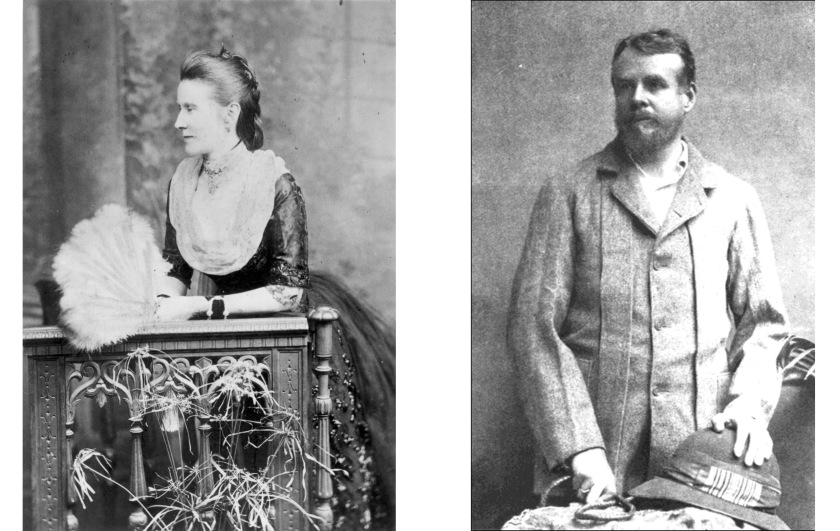
Fig. 3: James Theodore Bent (unknown date, after an image in the Illustrated London News, 1897, private collection)
Instead, the couple shortly embarked on a sequence of (illicit) investigations along the Turkish littoral (in particular the coastline opposite Rhodes), which proved fruitful: some of Bent’s marbles from this expedition are now in London at the British Museum (and a search of its on-line catalogue will turn them up). Bent briefly wrote up his discoveries of ancient Loryma, Lydae, and Myra for the Journal of Hellenic Studies (1888, Vol. 9, 82-7), but a lengthier account was provided by E. L. Hicks (‘Inscriptions from Casarea, Lydae, Patara, Myra’, 1889, Vol. 10, 46-85), including transcriptions of over forty inscriptions and passages of text from Theodore’s own notebooks (which are rare, as many of his original notebooks are now missing).
But let’s cut back to Mabel in the Hôtel de Byzance, and that reference to Sutton Hall:
‘We left England on January 19th Thursday, travelling from Sutton Hall to Marseilles, which we reached at 12.10 pm on Saturday morning and went to bed at the Station Hotel. We varied our journey by going for our meals to the Waggon Lits dining car. We embarked in the afternoon on board the Messageries steamer La Bourdonnais, with only one passenger besides ourselves and a captain’s wife going to join her husband. We had dreadfully stormy weather after Cape Matapan and had to shelter 20 hours in the island of Seriphos, always eating with fiddles on the table. We only got to Syra on Thursday. We landed and found to our sorrow that our kind consul Mr. Binney was dreadfully ill. At Smyrna we visited Mr. Disinnis and he seemed nearly worn out from nursing his wife. We reached Constantinople on Saturday [January] 21st and after an odious landing in a downpour of rain, our goods being as usual opened in a passage roofed over only, we found ourselves again in the Hôtel de Byzance. There is not much to tell of our stay there. Our great object was to obtain a firman, permitting us to dig in Thasos and have a share of the finds. With this object we went to visit Hamdi Bey, the head of the museum, accompanied by Mr. Wrench, our Consul… Hamdi is a very agreeable foe. He is a painter and has been educated in Paris and has married 2 French wives in succession. We were at his house 2 years ago. He was extremely polite and most willing that we should dig “for the love of science” and the benefit of his museum. His wife is a pretty, bright little woman, who, though she receives everyone at home, has to go out in a yashmak… We went twice, our second visit was to say we had given up wishing for a firman, as we were not justified in digging for nothing. Hamdi seemed annoyed at this but was none the less civil. Mrs. Hamdi took me upstairs to see her 2 children, Leila aged 10 and Edhem 4, called after his grandfather, His Highness Edhem Pasha, who was himself, or was the son of a slave. I also saw her mother, an untidy old woman in a dressing gown, and I had coffee.‘
[The Chronicles of Mabel Bent, Vol. 1, 228-9, Archaeopress, 2006]
And all a long way from rural Cheshire. The modest grand house of Sutton Hall, a few miles from both Macclesfield and Chesterfield, has sturdy Norman roots: for a period of time in the late 19th century it just also happened to be leased to Theodore Bent – arguably one of the pioneers of Cycladic archaeology (1883/4); controversial surveyor of ‘Great Zimbabwe’ for Cecil Rhodes (1891/2); and searcher for traces of the Queen of Sheba along the daunting Hadramawt (1894/5). [A select bibliography follows]
Wikipedia informs us that:

‘The house is constructed partly in stone, and partly in timber framing, with a U-shaped plan. The arms of the “U” end in irregular gables. The left gable is in stone, and the right is timber-framed. The upper storey of the right gable is jettied, the jetty being supported on brackets carved with wooden figures, one a knight in chain mail. Between the two wings is the former great hall. A 16th century chapel at the rear of the house, which has served at different times as stables and as a convent, now serves as the restaurant kitchens. The house is recorded in the National Heritage List for England as a designated Grade II listed building.’
and that:
‘Once the property of the Sir Humphrey Davenport, Chief Baron of the Exchequer in 1631, the Manor of Sutton later passed by marriage to Sir Rowland Belasyse, an ancestor of the Earls of Fauconberg. In 1819 it was acquired by the Countess of Lucan and descended to her successors, the Lords Lucan, primarily used as a farmhouse. The countess had been born Elizabeth Belasyse, daughter of Henry Belasyse, 2nd Earl Fauconberg and in 1794 had married Richard Bingham, who became the 2nd Earl of Lucan in 1799. By 1804, after six children, they had separated.’ [https://en.wikipedia.org/wiki/Sutton_Hall,_Sutton_Lane_Ends]
In its present incarnation, the erstwhile Bent residence is a pleasant, out-of-the-way gastro-pub and very worthy of a detour and lunch. [GPS= 53.240306854248,-2.1160869598389. A potted history and photo gallery is available at http://www.brunningandprice.co.uk/suttonhall/homepage/%5D
Local historian Alan Dinnis adds:
‘The Bents had been in the Sutton area for some time. Back in 1838-39, when St James’ Church was planned, members of the family contributed a total of ten pounds to the building fund. In the 1860s, when it was customary for church pews to be rented, “The Misses Bent” held eight seats with another four seats for their “domestics”. Theodore owned The Elms in Byron’s Lane and had another house in London. He also held the lease (from the Earl of Lucan) of Sutton Hall, which was occupied by his Aunt Maria.’ [personal communication, Oct 2011]
Sutton Hall was initially leased by Bent’s parents, James Bent and Margaret Eleanor (née Lambert, daughter of wealthy Baildon (near Bradford) locals, John and Ann Lambert of Baildon Hall), who married in April 1848. The Bent family could be traced back some generations in the north of England, related to the splendidly-named Hamlet Bent (1642-1728). Another branch of the family included the distinguished surgeon Sir James Justin Bent, who amputated Josiah Wedgewood’s right leg in May 1768. Sir James resided in Basford Hall (near Leek, Staffordshire) and it was his family crest that was adopted and adapted by other members of the extended family – including Theodore: the ‘demi-lion azure’ featuring on his stationery. One family motto was ‘Nec Temere, Nec Timide’ – ‘neither reckless, nor timid’. Bent was never the latter. (Theodore (he dropped his first given name – James) was born in thriving Victorian Liverpool on 30 March 1852 – an uncle, Sir John Bent, was Lord Mayor of the city in 1850-51.)
The non-medical Bents made their wealth collectively in the pottery and brewing trades – making both beer and the means of supping it being rather canny. The business ‘Bent’s Brewery Co. Ltd.’ only disappeared as a trade name in the 1960s.
As well as their fine home in Baildon, and assorted properties in the area, Theodore’s father (presumably) also leased Sutton Hall, it seems as a home for his sister and those of his brothers, and which was to become the favourite English summer residence of his son Theodore and his wife Mabel.
Within a year of his father’s death, with Theodore 25 and Mabel 30, the couple announced their engagement (the couple having met in Norway) and a few months later, in August 1877, the local Cheshire and Yorkshire newspapers (York Herald, 6 August, and Cheshire Observer, 8 August 1877) printed a marriage notice:
‘On the 2nd inst. at Staplestown Church, county Carlow, Ireland, by the Rev. Charles Lambart, uncle of the bride, assisted by the Rev. H. A. Barker and the Rev. T. Hatchell, James Theodore Bent, of Sutton Hall, in this county, to Mabel Virginia Anna, second sister of the late Robert Westley Hall Dare, of Newtonbarry House, County Wexford.’
In the summer of 1885, Theodore (now comfortably off) put up for sale five freehold cottages and premises (totalling about four hectares) at Brook Hill, Baildon (and a freehold close of land in Slaughter Lane) at auction. The young explorer was left with Baildon House and his property interests in Sutton. (Anglo-Irish Mabel had access to lands of some grandeur in Co. Wexford and Theydon Bois, Essex, where the couple rest together today in the Hall-Dare plot in St Mary’s church.)
From 1880, at least, the Bents also leased property in London. In 1880 they were in 43 Great Cumberland Place (near Marble Arch) and a few years later they were in number 13, in which Mabel continued to reside in rather lonely isolation until her death in 1929. It is unclear what happened to the lease at Sutton Hall up until Mabel’s death in 1929, but at Theodore’s death in 1887 it was incorporated into his trust estate:
‘…I bequeath to my Aunt Maria Bent her executors administrators and assigns absolutely All that my leasehold messuage called Sutton Hall Macclesfield wherein she now resides for all my term and interest therein she paying the rent and observing and performing all the covenants and conditions contained in the lease thereof. I devise all my freehold or copyhold estate at Sutton near Macclesfield aforesaid called “The Gurnett” unto my trustees…Upon trust to permit my said Aunt Maria Bent during her life to receive the rents and profits thereof and from and after her decease I declare that the said freehold or copyhold estate shall sink into and become part of the trust estate hereinafter mentioned…’ [‘Clause in Will of J T Bent, signed 21 Jan 1891 (died May 1897, no other wills known by me but further codicils may have been added)’]
It seems that ‘The Gurnett’ was linked in some way with the property referred to (see above) as ‘The Elms’. This residence was perhaps in turn rented out, as in 1895 it was the residence of one ‘Alderman John Birchenough JP… a prominent local politician and silk manufacturer’, and described as ‘a pretty mansion in Byrons’ Lane, Sutton…’ [https://en.wikipedia.org/wiki/John_Birchenough]
The Daily News of 21 August 1897 records that Theodore’s personal estate on his death was valued at £21,497, and refers to the deceased as ‘the well-known traveller and archæologist’.
Sutton Hall pub’s own website has an interesting archaeological snippet:
‘In the grounds of Sutton Hall there is a somewhat dilapidated Bronze Age barrow (now the resting-place of a water trough). In 1962 the barrow was again excavated, by James Forde-Johnston of Manchester University, who unearthed evidence of several further cremations. He discovered that the mound had originally been around 100 yards in diameter, but was substantially reduced, with many of the river cobbles having been removed to the nearby farmyard for use in paving, where they can still be seen.’ [http://www.brunningandprice.co.uk/suttonhall/history/]
Bent would most certainly have known of it (probably a cremation site, now much reduced in size), and in all likelihood taken a spade to it, although we have neither record nor proof: although the ‘somewhat dilapidated’ is perhaps one clue (!) and a search for Forde-Johnston’s notes (this current author has not attempted to) might reveal others.
Theodore did however make several notable archaeological discoveries, and very often refers to himself as an ‘archaeologist’, however he is not recognized quite as such by today’s practitioners. Although the discipline was already well advanced by the late 19th century, Theodore was much more artefact- than context-lead as an ‘excavator’, more interested in recovering material to return with to England (and perhaps to deal in) than interpreting and communicating a wider understanding of the site he was excavating. In a similar way, he was often handicapped by his own theories – for example his notorious work at ‘Great Zimbabwe’, the discrediting of which caused Mabel such distress after his death. So, perhaps then archaeologist, no; but explorer-traveller, adventurer, even antiquarian and ethnographer, emphatically yes. Great British travellers, travel-celebrities even, indeed. Bent would be a TV presenter today – Jago Cooper if not Michael Wood.
Sutton’s local church of St James’ contains a sweep of memorial windows to the Bents. Theodore installed one for his father († Dec 1876) and mother († Nov 1873). And their son, in his turn – and nicely depicted as St James – has one donated by his widow. In the church guide we read:
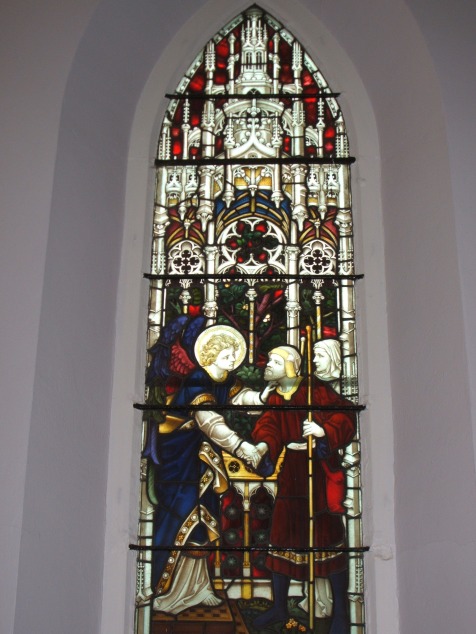
‘This window is dated 1897 and depicts a pilgrim ending life’s journey at the gate of Heaven and being welcomed by an angel. The pilgrim is dressed as St James. There is a scallop shell in his pilgrim’s hat… The window is in memory of J. Theodore Bent, of Baildon House, Yorks, and Sutton Hall, who died on 5th May 1897 aged 45. It was given by his widow Mabel, of 13, Great Cumberland Place, Middlesex.’ [Alan Dinnis, St James’ Church, Sutton: 1840–1990, Macclesfield 1990, 136]
The Cheshire Observer of 27 November 1897 provides more information:
‘Mrs. Mabel V. A. Bent, residing at 13, Great Cumberland Place, London, applied for a faculty to place a stained-glass window at the east end of the church, as a memorial to the late James Theodore Bent, a former parishioner. The cost (£72) would be defrayed by Mrs. Bent. – The faculty was granted.’
It is a fine, long window (dated 1896 curiously), depicting the pilgrim (a.k.a. Bent) being welcomed by an angel at heaven’s gate. The caption reads: ‘To God’s glory and in remembrance of J. Theodore Bent. FRGS, FSA. Son of James and Margaret Eleanor Bent of Baildon House, Yorks, and Sutton Hall. Died May 5 1897, aged 45.’
Mabel specified two quotations: ‘The highways were unoccupied and the travellers walked through byways’ (Judges 5:6) and ‘They were strangers and pilgrims on the earth’ (Hebrews 11:13). Mabel and Theodore are reunited in these lines. (There are other memorials to the Bents and Hall-Dares in Baildon (St John’s), Theydon Bois (St Mary’s), and Bunclody (Co. Wexford, also St Mary’s.)
But Sutton Hall was to remain one of the Bents’ happiest homes and they spent time there as often as they could – their routine from the early 1880s until Theodore’s death in 1897 was to travel in English winters and return to England and Ireland for summers and autumns. As well as visiting family and friends, Theodore would spend these periods writing, lecturing, and preparing for the next season and the beeswaxed and grandfather-clock-ticking rooms of Sutton Hall would have been furnished with the desks and tables on which Theodore worked on many of his books (a select bibliography concludes this essay) as well as the hundreds of letters (his correspondents including Rider Haggard: did he have Bent in mind as Allan Quatermain?), as well as the articles and lectures he generated over the twenty or so years of travel.

As one example, alluded to above, Theodore spent a good deal of the summer and autumn of 1887 trying (unsuccessfully) to drum up enough support to have some of the fine marbles he uncovered on Thásos saved for London; the Turks claimed them, the Greeks were dispossessed – today most are in Istanbul. Letters exist from Theodore at a series of addresses in Herefordshire (mostly vicarages), and Sutton Hall to senior staff at the British Museum:
‘… We have indeed been unfortunate about our treasure trove [sic] but I have hopes still. I sent to Mr. Murray [of the BM] a copy of two letters which recognize the fact that I had permission in Thasos both to dig and to remove… Seriously… Thasos is wonderfully rich and I have some excellent points for future work and if we could by not being over grasping get the Turkish govt. to recognize the [position] I am confident we could produce some excellent results.’ [Bent’s letter to Arthur Smith at the British Museum, 4 Sept 1887]
As for Sutton’s later role in the lives of the Bents, future research, we hope, will uncover the story of Mabel’s holidays, as a widow, at Sutton Hall, but we may assume that Theodore last saw the house in the summer and autumn of 1896 before leaving for Sokotra and Aden – his final journey.
At Aden, the Bents – with their long-serving assistant Matthew Símos (from Anáfi in the Greek Cyclades) – set out on 27 February 1897 for their last explorations together into the territories east of Aden. They were clearly weakened after their stay on Sokotra, and on March 16 Mabel records that: ‘Theodore was in a raging fever so that I had to tell him I was now much better and had got quite strong, so I could take care of him…’ (Mabel’s Chronicle for March 1897), and it was clear that the expedition would have to be aborted: the arduous trek back to the South Arabian coast, and onward boat-journey to Aden, would have to be made as soon as possible. With great difficulty, the stricken travellers were aided down to the coastal town of Shuqra for the 100km return sail to Aden, and by 26 March 1897 they were all in the hospital there.
Mabel’s letter (from London) to Scott Keltie at the Royal Geographical Society, London, just before Theodore’s death, sums up their acute distress at the time:
‘Dear Mr. Keltie… We got home on Saturday night [1 May 1897] in a most wretched state. We have had malarial fever and I have been ‘dangerous’ in Aden and now it is my poor husband’s turn. He got a fresh attack just getting home and pneumonia. He is a little better today but not out of danger – but I have good hopes though awfully anxious as the Drs. shake their heads. We have one sleeping in the house and 2 nurses as I am no good yet. I had to be carried to the steamer in an ambulance litter… We have had an awful time – bad enough without this. I have one of my sisters so have good help. He made little maps fitting on to each other but just yet I seem not to know where they are. When as I can’t help thinking he is better I will ask you to come and see the things. I was pretty lucky with my photos. We nearly got to the coast at Shugra before we got the fever, through part of the Beled Fadhli again – We were in the hospital at Aden… Yours truly, Mabel V. A. Bent’
Despite the attentions of Mabel, her sister Ethel, a resident doctor and two nurses, Theodore did not ‘get better’, succumbing just a few days later on 5 May 1897. (He is buried in his wife’s family plot at St Mary’s, Theydon Bois: there is a memorial stone to them both; you can visit.)
Sutton Hall witnesses this next sad letter written by Mabel, as, on top of everything else, with her uncle Francis also dying in May, she was faced with the melancholy task of unpacking all their botanical specimens for Kew. From Sutton Hall (on black-edged paper), she writes (24 May 1897) to Kew director, Sir William Thiselton-Dyer:
‘I don’t know how to thank you enough for your letter, it was so kind. People have been so good in writing to me and though of course one cannot be consoled it is a pleasure to feel my husband was appreciated and that my friends share my great sorrow. He was always occupied and so happy in his work. Of course he collected some flowers and I shall have to unpack them soon and I should like to take them to you on Friday or Saturday which ever day and time suits you. One of my sisters is with me and we go up to town on Thursday morning to be ready for the valuations and then I must unpack all our ‘long sea’ baggage and camp furniture which will be very sad and painful. [Mabel adds a postscript from London here] I wrote so far but now I find I am not strong enough. I have unpacked this morning and I am sure the things want attending to as the bulbs are growing and I am alarmed about some of the cactuses. Could you send someone to get explanations or come some afternoon. Please let me know when. Soon would be best as after the 1st I think the valuators will infest the house… With kind regards to Mrs Dyer, Yours very truly, Mabel V. A. Bent’ [Black-edged letter, 24 May 1897 from Mabel Bent at Sutton Hall, Macclesfield, to Thiselton-Dyer. On reverse: ‘Ansd 29.v.97. Mr. Watson to go on Monday afternoon. Parcel of dried plants, bulbs, seeds etc. from Arabia and Socotra brought to Kew. Ackd 4.6.97’ (Kew Archives: Directors’ Correspondence, Vol. 179, 8)]
This trip that cost Theodore his life produced the least return. There were no major archaeological finds: a very few artefacts are now in the British Museum and Pitt Rivers Museum, Oxford. There were some plant specimens for Kew, as usual, and a few land snails are in drawers in the Natural History Museum, London.
We must wait for a suitable Bent memorial at the gastro-pub that Sutton Hall now is (although at the upstairs windows one might glimpse drawn faces still), but just along the church lane, on the little hill that offers up St James’, Theodore, from his stained glass window, looks out south and south-east towards their remarkable routes and researches in the Mediterranean, Africa, and Arabia: thousands of land- and sea-miles, on hundreds of steamers, small boats, horses, mules, camels, and ox-carts to ‘Great Zimbabwe’. Today’s pub visitors have no idea – but, inside, the dark, Victorian rooms crackle with Empire and the small-talk of archaeologists.
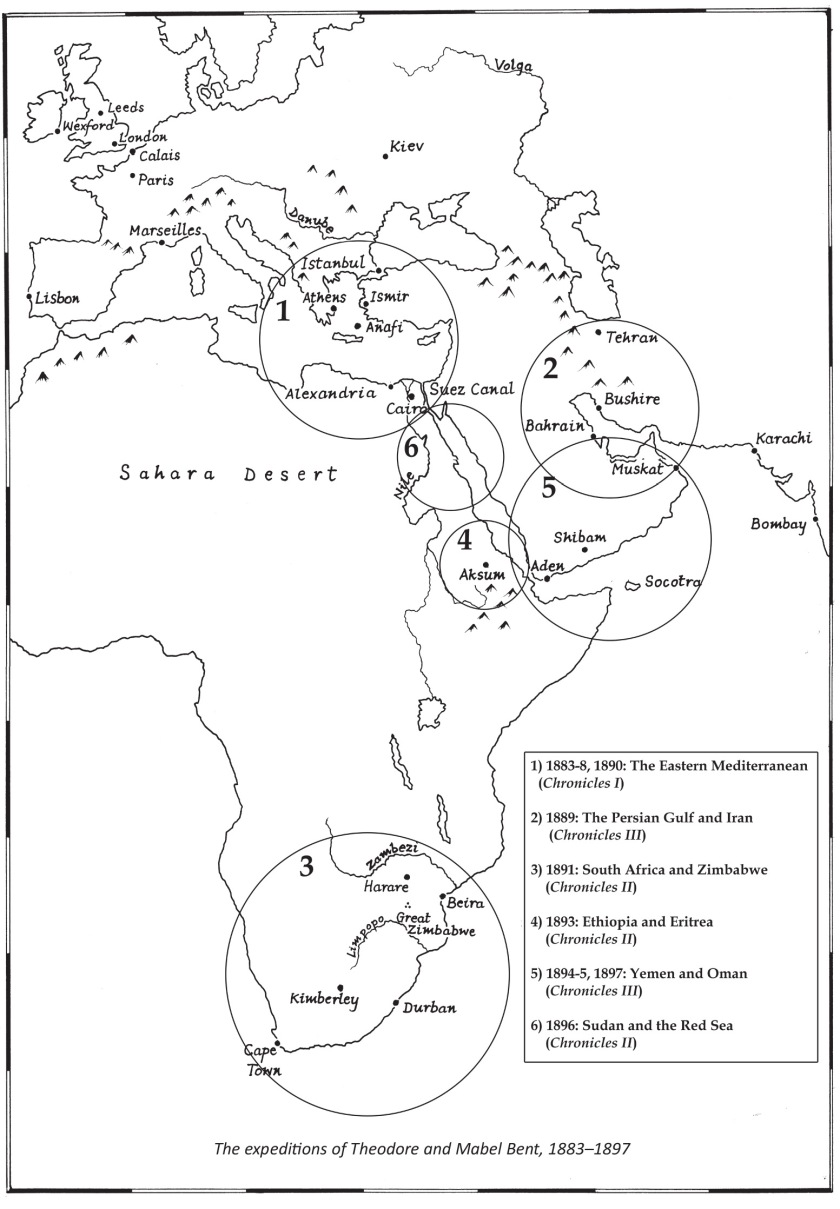
(c) Gerald Brisch, August 2017
Acknowledgement: The author would very much like to thank Robin Barber for a communication that inspired the above article.
A select bibliography
Bent, J. T. 1877. A Freak of Freedom (London).
Bent, J. T. 1881. A Life of Garibaldi (London).
Bent, J. T. 1881. Genoa, how the Republic Rose and Fell (London).
Bent, J. T. 1885. The Cyclades; or, Life Among the Insular Greeks (London).
Bent, J. T. 1892. The Ruined Cities of Mashonaland (London).
Bent, J. T. (ed.) 1893. Early Voyages and Travels in the Levant (London).
Bent, J. T. 1893. The Sacred City of the Ethiopians (London).
Bent, J. T. and M. V. A. 1900. Southern Arabia (London).
Bent, J. T. , Bent, M. V. A. and Brisch, G. E. (ed.) 2015. The Dodecanese: Further Travels Among the Insular Greeks (Oxford, Archaeopress).
Bent, M. V. A . and Brisch, G. E. (ed.) 2006. The Travel Chronicles of Mrs J. Theodore Bent. Volume I, Greece and the Levantine Littoral (Oxford, Archaeopress).
Bent, M. V. A . and Brisch, G. E. (ed.) 2012. The Travel Chronicles of Mrs. J. Theodore Bent. Volume II: The African Journeys (Oxford, Archaeopress).
Bent, M. V. A . and Brisch, G. E. (ed.) 2010. The Travel Chronicles of Mrs J. Theodore Bent. Volume III: Southern Arabia and Persia (Oxford, Archaeopress).
A fuller Bent Bibliography and other information on the Bents is available at: www.tambent.com
[All above websites accessed August 2017]
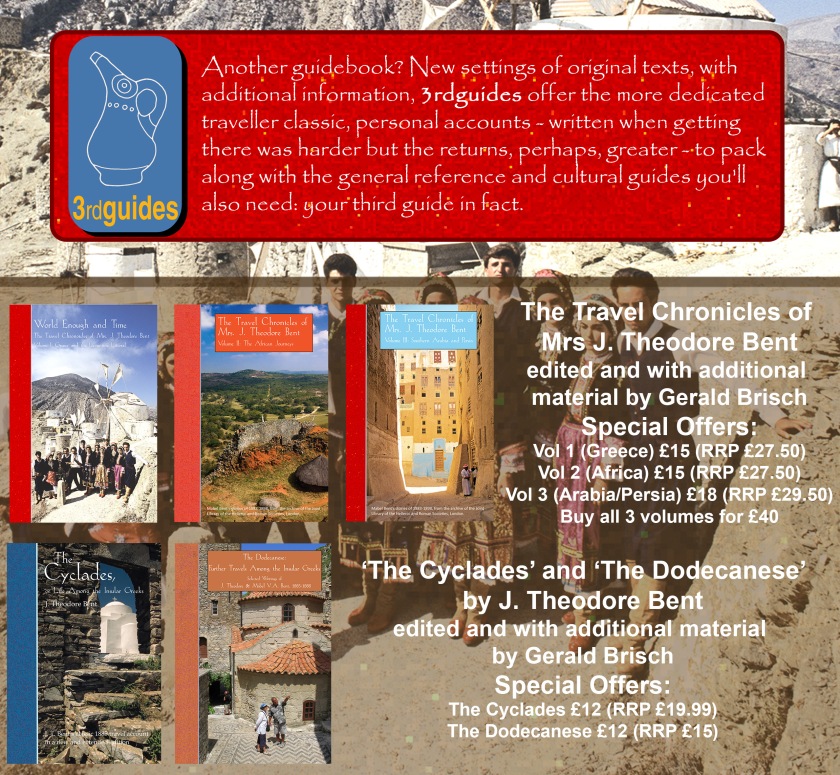
Visit the Archaeopress website to view the 3rdGuides range of publications including Mabel Bent’s Travel Chronicles Vol 1-3, written during the couples’ excursions to Greece, Africa, Arabia and Turkey (1883-1898), a new edition of Theodore Bent’s The Cyclades (1885) accompanied by a newly commissioned biographical introduction and a series of notes including route-planner, and historical and archaeological summaries, and a volume of compiled papers, notes and travel-writings, The Dodecanese (2016).
The above books are available at special prices until 30/09/2017.

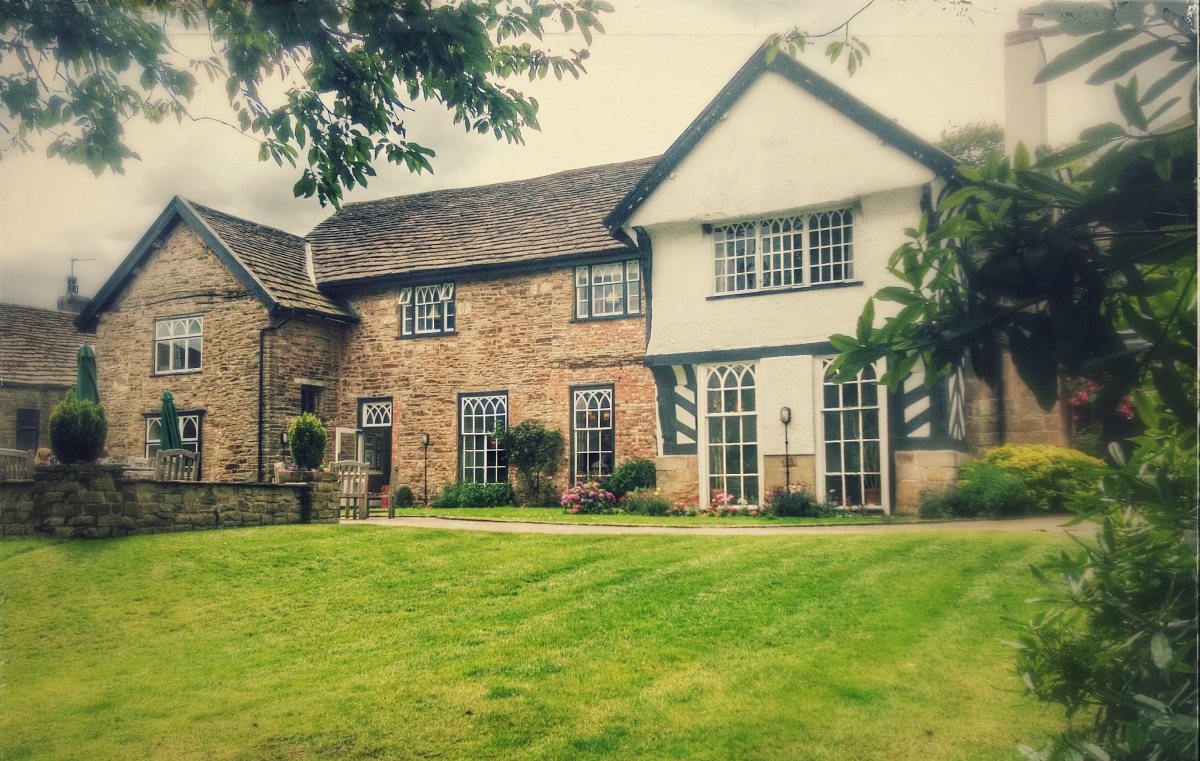
A very interesting piece – thank you so much for taking the trouble to publish it. I always find it interesting how date and days could become confused in travel diaries of the 18th and 19th centuries (I am afraid that I have only worked with travellers’ diaries of this period, and am not familiar with those of the earlier centuries). Keeping track of time must have been a very difficult thing to do when travelling then. Your first quotation is a great example of that. They left Sutton Hall on the 19th January (Thursday) 1888, and arrived in Marseilles on the Saturday (which might have been either the 21st January or the 28th January). They then took a long cruise from Marseilles to Constantinople, stopping at Seriphos, Syra and Smyrna and perhaps other places unmentioned, and arrived in Constantinople on “Saturday the 21st”. You naturally supplemented [January], but that cannot be correct as they may have arrived in Marseilles on that day or have still been in transit between Sutton Hall and Marseilles. The next Saturday the 21st was in April, but I doubt that it would have taken that long to travel between Marseilles and Constantinople, so somewhere along the way either her grasp of the dates or weekdays slipped. Sadly, indications of date and day must always be subject to question in diaries such as these!
LikeLike
Michael – if I may – I’m so sorry but I was only just notified of this comment! It is extremely helpful and I will dig into Mabel’s diaries again for more clues! You are quite right – dealing with Mabel’s diary dates can be like attempting Linear A! Kind regards and again apologies for this great delay and many thanks for taking the trouble to comment. If I can get an answer I will reply again…..Gerry Brisch
LikeLike
On checking again Mabel’s diary for 1888 there are a couple of clues that seem to fix the date of Saturday, 4 February for the Bents’ arrival at ‘Constantinople’. Mabel gives a weather report for the next day, ‘The snow began on Sunday the 5th and went on for a week, a metre deep and more where it drifted…’ And that on Friday, 17 February they made an outing to Broussa.
LikeLike
Theodore Bent’s name appears in a copy of the old deeds from the late 1800s of my house in Gurnett. It shows him as owning the adjoining land around Gurnett House. This is a large 16th Century house about 100 yards from Sutton Hall.
LikeLike
Peter – if I may – I’m so sorry but I was only just notified of this comment! It is extremely interesting and I did know that Bent had some link to ‘the Gurnett’. If you would ever care to share with me a reference/citation to the deeds in question I would very much like to include it in our main Bent site http://www.tambent.com. Kind regards and again apologies for this great delay and many thanks for taking the trouble to comment. Gerry Brisch
LikeLike